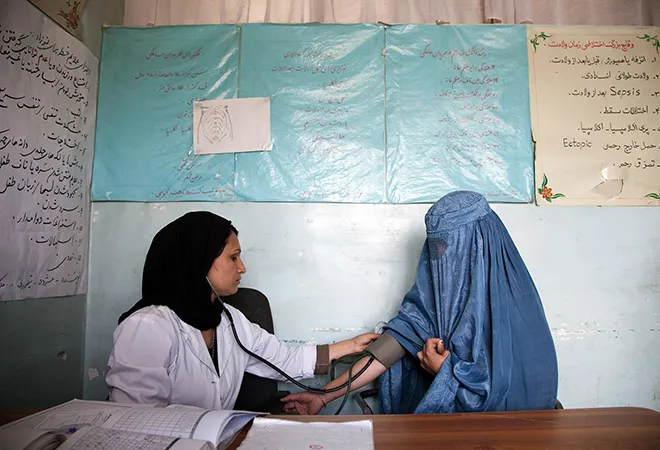-
CENTRES
Progammes & Centres
Location
In the midst of growing political instability, emerging complexities in the peace process, and significant aid cuts, the coronavirus outbreak is intensifying the struggle on all fronts in Afghanistan.

As the world struggles to deal with the devastating impact of COVID-19, Afghanistan is stuck in the clutches of not one but multiple crises that are interdependent, and continuously exacerbating each other. Despite the Afghan government releasing 300 Taliban fighters and the Taliban following up with the release of 20 Afghan security personnel, the intra-Afghan talks and as a result, the peace process, have hit a snag.
The Taliban had demanded the release of 15 of their senior commanders in the first phase of prisoner swap, while the government stood steadfastly against it, releasing only low-risk inmates, in a piecemeal manner. As expected, the Taliban have threatened to resume full scale attacks if terms of the agreement with the US — a significant condition being the release of 5,000 militants — are not met.
Politically too, the situation is fragile as the two rival camps that emerged as a result of the disputed presidential election, that of Ashraf Ghani and Abdullah Abdullah, have refused to reconcile differences to form an inclusive, united government. US Secretary of State Mike Pompeo’s recent visit aimed at facilitating a compromise between the two parties also failed, and led to the US initiating massive aid cuts to Afghanistan.
In the midst of growing political instability, emerging complexities in the peace process, and significant aid cuts, the coronavirus outbreak is intensifying the struggle on all fronts in Afghanistan. As on 15 April 2020, with 56 new cases reported in the last 24 hours, the total tally of those infected stood at 840, as per the Afghan Ministry of Public Health (MoPH).
There have been 30 deaths due to COVID-19 in the entire country, and the number is likely to shoot up over the next few weeks. A key laboratory at the Afghan-Japan Hospital in Kabul, one of the few that are equipped to test samples for COVID-19, have stopped taking in new testing requests due to a massive backlog of tests to be conducted. The laboratory has the limited capacity of testing 300 samples in 24 hours, but thousands of samples are submitted every day.
While some analysts are raising doubts about the government underreporting the cases and concealing the ground reality, what remains undisputed is the gross inadequacy of the Afghan healthcare system to deal with a crisis as extensive as the coronavirus. The nation’s Global Health Security (GHS) Index is 32.2, which suggests that the country’s healthcare system is one of the most ill-prepared infrastructures, to deal with the threat of potential crises such as COVID-19. In other words, the lack of contingency planning for health crises, limited abilities for early detection and testing, and the inability of the healthcare sector to operationalise preparedness owing to lack of funding, could prove disastrous for the country, especially in the case of the current pandemic.
On 15 April, the Ministry of Finance (MoF) announced that the government needed around $400 million to be able to adequately respond to the deadly challenge posed by the coronavirus. Given the recent US decision to cut $1 billion in aid, and the largely foreign aid-dependent nature of the Afghan economy, it is not surprising that the establishment has turned to requesting additional aid from international donors, and is transferring funds from existing budgetary units into the country fund for COVID-19.
Around $140 million has been appropriated collectively from the World Bank and Asian Development Bank funds at the disposal of the government. Afghanistan also featured in the list of 25 vulnerable countries that will be recipients of the immediate debt service relief, provided by the International Monetary Fund (IMF) under the Catastrophe Containment and Relief Trust (CCRT), aimed at addressing the impact of the COVID-19 pandemic.
Despite persistent risks and insecurity, the borders of Afghanistan have witnessed a steady influx of Afghan migrants returning from Iran and Pakistan. While the number of migrants that crossed over into Afghanistan from Iran stood at 60,000 in March, over 1,500 Afghans continue to return home every day. Additionally, thousands of Afghan citizens crossed over from Pakistan into Afghanistan when the border was temporarily reopened the week before.
Given that Afghan migrants in both Iran and Pakistan usually work as daily wagers, the impact of COVID-19 for them is likely to be beyond health. The work of contractual labourers has suddenly ceased to exist in the presence of various region-wise lockdowns, rendering the workforce income-less, fighting for their survival everyday.
While Afghan migrants in Iran and Pakistan are struggling to meet daily living costs of food and accommodation, let alone pay medical expenses, the condition of workers in Afghanistan is as bad. With the closure of more than 36,000 shops and factories in the province of Herat since lockdown was announced almost a month ago, thousands of workers have lost their jobs. Construction work and infrastructure development work has also stopped in the province, aggravating poverty levels and threatening the very survival of a large section of the population.
On 13 April 2020, the Health Minister Ferozuddin Feroz addressed the parliament and said that carelessness and a lack of adherence to recommended health practices, will exacerbate the impact of the pandemic, leaving each citizen more vulnerable than before, to contracting the virus. While the onus of limiting the spread of the virus indeed lies with the people at large, it is incumbent upon the government to effectively utilise the support being extended by international organisations/donors, to enhance the capacity of healthcare personnel and the larger health infrastructure of the country, in order to fight the pandemic.
This commentary originally appeared in South Asia Weekly.
The views expressed above belong to the author(s). ORF research and analyses now available on Telegram! Click here to access our curated content — blogs, longforms and interviews.

Shubhangi Pandey was a Junior Fellow with the Strategic Studies Programme at Observer Research Foundation. Her research focuses on Afghanistan particularly exploring internal political dynamics ...
Read More +